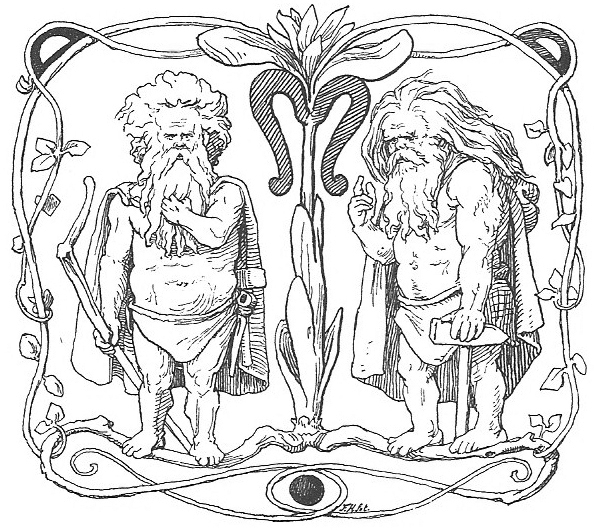Star Foster asked: The Asatruar rituals I have seen call on the four dwarves holding up Ymir’s sky-skull. It’s an awful lot like calling the corners in Wicca. Is there any controversy over the similarity?
To answer this question, I’m going to back out a bit to the bigger picture to hopefully explain the connection from what we know of the ancient past, to certain aspects of the evolution of the modern religion and how it is practiced today. When someone goes searching through the vast amounts of ‘lore’ (sagas, skaldic and eddic poetry), as well as accounts written by outside travelers (like the Romans, or various Muslim travelers) to try to reconstruct religious practices, while there are indeed many references to such practices, unfortunately they tend to be rather brief and essentially consist of “they held a ritual”, which in the scheme of things isn’t terribly helpful for those of us today who would like to know exactly how such rituals may have been performed.

One of the few detailed surviving examples for a ritual comes from The Æcer Bót found in the Anglo-Saxon text, Lácunga. Unfortunately, this ritual has been Christianized and focuses on rectifying problems with the land whether it is infertile for some natural reason or if something unwholesome had been done to the land through some form of sorcery. So it’s not terribly useful for most people who are looking for a ritual structure that they can use to honor the Gods.
One of the most thorough descriptions of a ritual, can be found in Heimskringla, as it outlines a specific ritual known as blot. The word blot derives from the Old Norse word for ‘sacrifice’ and indeed refers to animal (and sometimes human) sacrifice. In the modern context many in the Northern Tradition use the term blot to refer to any ritual where items are given in offering specifically to the Gods. There are a few believers who choose to only use the term to refer to an actual animal sacrifice, and for other type of rituals with offerings given specific to the gods (ancestors, etc.) these persons tend to opt to use an alternate term faining instead for these rites sans blood sacrifices.
HALLOWING IN THE ANCIENT PAST
Rituals were usually conducted in sites that were already attributed by ancient believers as being sacred sites, these included sacred groves, temples, and so forth. We don’t see much mention in the lore as to how these sites were specifically consecrated or hallowed, or if they needed to re-consecrated with every rite.
We do know that depictions of Thor and/or his hammer were used as a means of consecration or blessing as found in Bronze Age rock carvings, Danish and Swedish runestone inscriptions, as well as in the consecration of marriage as seen in Þrymskvida. We also know thanks to Heimskringla’s Saga of Hakon the Good that there’s at least one reference to the sign of the hammer being made (although the context of this particular tale suggests this may not have been a normal occurrence).
Now why do we see SO much evidence of Thor as a consecrator here, and not much with the other Gods? The ancient cultures that worshipped these Gods were primarily oral in nature, and we see that there are transitions in popularity with the Gods both as time passes, but also from one community to another. For whatever reason, at the time of Christian conversion Thor tended to be one of the more popular Gods, and since this was the period of time when we first begin to truly see a written record with these peoples much of our historical written texts are but a ‘snapshot’ of a culture that had existed for thousands of year in varying forms. Some scholars have theorized Thor’s prominence during this period of time may have been because of his function as a defender of Asgard and Midgard in the tales, so that as native heathens felt their way of life threatened by the encroachment of Christianity they turned to HIM to protect their faith.
So do we know of any ancient types of consecration that may have referenced the cardinal directions?
The Æcer Bót does reference physically taking tufts of sod from the 4 corners of the unwholesome land in question. While not being used specifically to hallow the space, certain things are done to these 4 pieces of sod to help rectify, cleanse and bless the whole of the land in question. To my recollection, this is the only thing that comes close to the ‘quarters’ being used in a ritual setting in the ancient past. Some other of the Anglo-Saxon Charms, feature evangelists names’ at the quarters, and so some theorize these were Christianized versions of earlier pagan rites that had Gods or other numinous beings at the quarters instead.
The only other mentions I recall to the directions comes in the snippets of our lore that tell our creation story.
Continued –>















